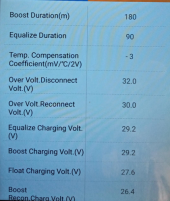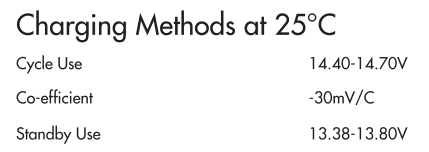Hi all,
I'm running 2 X 260Ah AGM batteries wired in series @ 24v.
Cycle use of the batteries are specified as
14.4 - 14.7v (28.8 - 29.4v @ 24v)
Float / standby specified at 13.4 - 13.8v (26.8 - 27.6v @ 24v)
I have some questions;
I have programmed my mppt bulk & absorption voltages at 29.4v. should I back off a little or is using maximum specified voltages recommend?
2nd question;
I have calculated the absorption time using the formula .42 x C20 / nominal current (rolls tutorial on YouTube)
I have therefore inputted the maximum absorption time into my mppt of 180mins (max time allowed on my controller)
What should the bulk charge time be set to? I currently have this set at 120mins. I cannot find a definite answer to this online and I believe battery manufacturers don't tend to specify this parameter.
Any help / advice appreciated
I'm running 2 X 260Ah AGM batteries wired in series @ 24v.
Cycle use of the batteries are specified as
14.4 - 14.7v (28.8 - 29.4v @ 24v)
Float / standby specified at 13.4 - 13.8v (26.8 - 27.6v @ 24v)
I have some questions;
I have programmed my mppt bulk & absorption voltages at 29.4v. should I back off a little or is using maximum specified voltages recommend?
2nd question;
I have calculated the absorption time using the formula .42 x C20 / nominal current (rolls tutorial on YouTube)
I have therefore inputted the maximum absorption time into my mppt of 180mins (max time allowed on my controller)
What should the bulk charge time be set to? I currently have this set at 120mins. I cannot find a definite answer to this online and I believe battery manufacturers don't tend to specify this parameter.
Any help / advice appreciated





